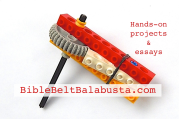Why let kids dangle boiled eggs over fire?
To candle-roast an egg is a quick, hands-on connection to what the seder plate egg symbolizes. It’s weird, it’s memorable and it is a kid magnet.
At home we do this with a match, but at my school Seder Step Program I used tea lights—they are stable, low—on a foil-covered plate. Students held the egg and rotated it over the stationary flame. I also offered a long-handled, spiral egg-separator or the Littles or for kids who needed more distance between fingertips and fire. The tool itself is irresistible and quite satisfying to hold.*
Signage helps set the scene and draw participants, but be sure you explain the Why of the roasted egg. The beitzah is a universal symbol of spring and birth, but also a particular symbol of the Temple: a sign of mourning for its destruction (eggs are classic shiva food), and most importantly, a stand-in for the roasted chagigah sacrifice back when Jews made pilgrimage for Pesach.
At the program, kids take their DIY roasted egg home to use for seder, but not until they’ve practiced with it. At the Set the Seder Plate station, they place their egg on a real seder plate along with all the other symbolic food they’ve just made, grated, mixed or plucked. This is the big, fat important step many kids don’t have the chance to do at home. I like to devote a whole class to it, but this year I added the lesson to the Passover program.
There are other ways to make the egg roast-y: with an oven, food torch, and BBQ pit, and also heat-free methods, like dyeing. None of these are cool with my particular setup. For classroom and for carnival, the candle is perfect.
Roasting vs. Dyeing:
Some folks dye the seder plate beitzah to look roasted. My friend, who grew up in the young state of Israel told me her family always dyed the beitzah in onion skins. I love messing with natural dyes, but the onion skin-egg trick takes time to boil on a stove, and I needed something quicker for my Passover station.
Easter egg dyes are quick, so I tried ’em in the privacy of my solitudinous kitchen: choosing tablets that, when combined, might produce a rich brown. I also tried food coloring: mixing the primary colors until purple gave way to chestnut. But in both cases, it felt wrong: me, a Jewish educator in the buckle of the Bible Belt a week away from Easter, dipping boiled eggs into tumblers of dye and vinegar, fiddling with those flimsy copper-colored egg dippers.
It also looked wrong, color-wise. I could not tweak the dyes to convince anyone that the egg had been in fire. The egg had clearly been in Paas tablets and McCormick drops.
Which brings me to the other reason to “roast” the seder plate egg:
I’d rather flame than dye—no matter what kind of dye—because the silly candle method has nothing to do with Easter. The egg on a seder plate already elicits enough comparisons with that other big spring holiday, so I like to keep the two eggy themes distinct.
There are legit Jewish traditions with eggs colored by a slow, Shabbat-cooking process—like my friend’s version of Sephardic huevos hamindos—and if I taught older kids or adults, sure, we could talk and make and compare. But my K-3s do not need category confusion. They need clarity.
These kids see are Easter eggs everywhere right now: pre-dyed eggs in clear containers at the grocery store, dye kits on the endcaps, egg-shaped cookies and cupcake toppers, creme eggs in the checkout aisle, plastic eggs in a bag for a buck, eggs, eggs, eggs, omg eggs. So, to hand out eggs and dye tablets at a Conservative synagogue program sends mixed messages with a megaphone.
Thus, fire.
Happy roasting!
*Tool: golly, I searched online and this spiral egg-separator is not very common. Found one or two at Amazon and Pampered Chef. BUT, you can use a big whisk, too: just push the egg through the flexible spokes of a nice, big whisk. The egg will stay caged while being roasted.






















I have been making huevos haminados for pesach since 1977. I don’t add vinegar, but otherwise the process is the same as the one in “The Kitchn.” I dampen the surface of the egg and press the parsley leaf in place. Then it’s simple to wrap a square of pantyhose around the egg and tie with a short piece of yarn. The eggs are beautiful and tasty. It wouldn’t be pesach without them.
Lynne, they sound lovely. The recipe says there is a slight onion flavor imparted. Do you find that to be true?
Hmmm, I never realised how much I needed one of those long handled tools (which I have no idea where to buy!) until I read this post.
And I just realized that these egg separator tools are not exactly the most common kitchen tool on the planet. Kinda hard to find. I just edited the post to include the tip that a plain ol’ whisk works just as well: squeeze the boiled egg between the spokes of a nice, big whisk. (Pushing the egg in and then out again is rather fun.)
quite slight